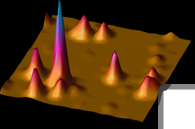Single-Molecule Projects
Single-Molecule Nanophotonics: Using
metallic nanoantennas to modify how a single quantum-mechanical
object interacts with light
(Reference: Moerner, Dickson, Norris: "Single-Molecule
Nanophotonics in Solids," Mater. Sci. Engr. B48 (1997) 169-174.)
Bowtie-FCS: Fluorescence Correlation Spectroscopy at High Concentrations using Gold Bowtie Nanoantennas
 Fluorescence correlation spectroscopy (FCS) measures the fluorescence fluctuations of fluorophores in solution, but is restricted to extremely low concentrations in the nM or pM range. Plasmonic gold bowtie nanoantennas enhance a single molecule’s fluorescence relative to a large background of unenhanced molecules, and here we show that gold bowties can extend FCS measurements to much higher concentrations. In our experiments, the bowtie-FCS signal is dominated by molecules that transiently stick to the substrate near the bowtie gap, and photobleaching/photoblinking dynamics for two fluorophores are measured on the 10-100 ms time scale. Bowtie-FCS may be useful in detecting binding interactions when high concentrations are required. Fluorescence correlation spectroscopy (FCS) measures the fluorescence fluctuations of fluorophores in solution, but is restricted to extremely low concentrations in the nM or pM range. Plasmonic gold bowtie nanoantennas enhance a single molecule’s fluorescence relative to a large background of unenhanced molecules, and here we show that gold bowties can extend FCS measurements to much higher concentrations. In our experiments, the bowtie-FCS signal is dominated by molecules that transiently stick to the substrate near the bowtie gap, and photobleaching/photoblinking dynamics for two fluorophores are measured on the 10-100 ms time scale. Bowtie-FCS may be useful in detecting binding interactions when high concentrations are required.
Anika A. Kinkhabwala, Zongfu Yu, Shanhui Fan, and W.E. Moerner, “Fluorescence correlation spectroscopy at high concentrations using gold bowtie nanoantennas,” Chem. Phys. 406, 3-8 (2012) published online 21 April 2012.[DOI] [ Slide] Slide]
Large Single-Molecule Fluorescence Enhancements Produced by a Bowtie Nanoantenna
 Due to the size mismatch between light and nanoscale objects like single molecules, it is important to be able to control light-molecule interactions. Plasmonic nanoantennas create highly enhanced local fields when pumped resonantly leading to increased Raman scattering, but whether fluorescence enhancement occurs depends upon a variety of factors. While sharp metal tips and colloids can enhance fluorescence, the highly enhanced optical fields of lithographically fabricated bowtie nanoantennas provide a structure that is more controllable and amenable to integration. Using gold bowties, we observe enhancements of a single molecule’s fluorescence up to 1340x, ten times higher than reported previously. Electromagnetic simulations reveal that this is due to greatly enhanced absorption and an increased radiative emission rate, resulting in enhancement of intrinsic quantum efficiency by an estimated factor of 9, despite additional nonradiative Ohmic effects. Bowtie nanoantennas thus show great potential for high-contrast selection of single nanoemitters. Due to the size mismatch between light and nanoscale objects like single molecules, it is important to be able to control light-molecule interactions. Plasmonic nanoantennas create highly enhanced local fields when pumped resonantly leading to increased Raman scattering, but whether fluorescence enhancement occurs depends upon a variety of factors. While sharp metal tips and colloids can enhance fluorescence, the highly enhanced optical fields of lithographically fabricated bowtie nanoantennas provide a structure that is more controllable and amenable to integration. Using gold bowties, we observe enhancements of a single molecule’s fluorescence up to 1340x, ten times higher than reported previously. Electromagnetic simulations reveal that this is due to greatly enhanced absorption and an increased radiative emission rate, resulting in enhancement of intrinsic quantum efficiency by an estimated factor of 9, despite additional nonradiative Ohmic effects. Bowtie nanoantennas thus show great potential for high-contrast selection of single nanoemitters.
Anika Kinkhabwala, Zongfu Yu, Shanhui Fan, Yuri Avlasevich, Klaus Müllen, and W. E. Moerner, "Large Single-Molecule Fluorescence Enhancements Produced by a Bowtie Nanoantenna," Nature Photonics 3, 654-657 (2009), published online October 18, 2009.[ Slide] [Journal Link] Slide] [Journal Link]
=======================Earlier publications======================
- Bowtie SERS Under Electrochemical Control [
 Slide] Slide]
- Surface-Enhanced Raman Scattering
with Bowties [
 Slide] Slide]
- Using Nanoantennas for Photopolymerization
of Resist [
 Slide] Slide]
- FDTD Calculations of Electromagnetic Enhancement for Bowtie Nanoantennas (Phys. Rev. B v. 72, 165409 (2005))
- Improving the Mismatch Between Light
and Nanoscale Objects with Gold Bowtie Nanoantennas - Measuring
the Local Field Enhancement [
 Slide] Slide]
- Gap-Dependent Optical Coupling
of Single "Bowtie" Nanoantennas Resonant in the
Visible [
 Slide] Slide]
- Pumping Single Molecules with Whispering
Gallery Modes of Microspheres [Abstract]
|



